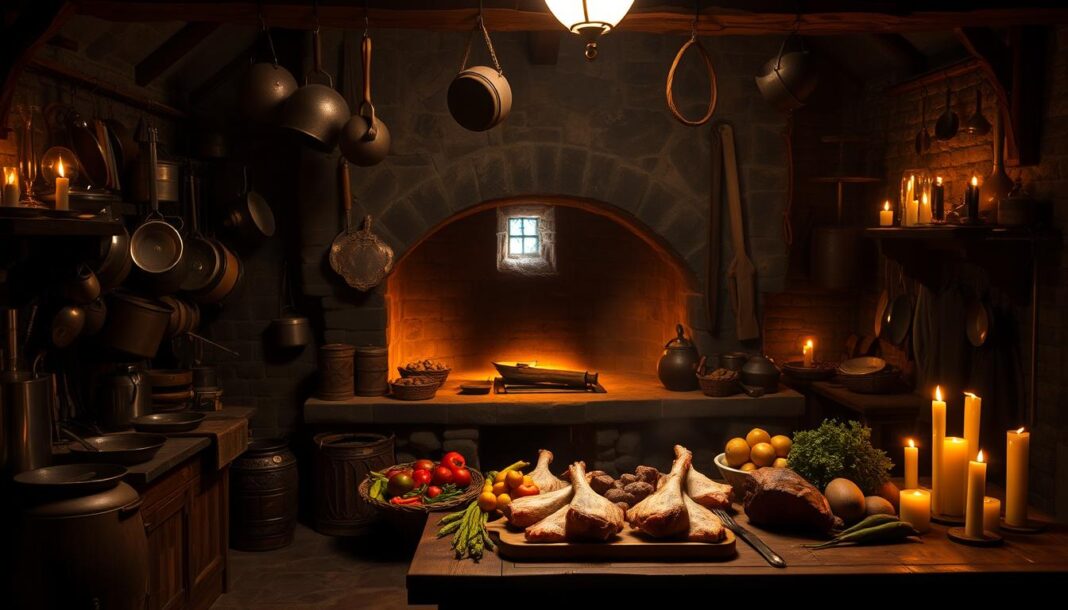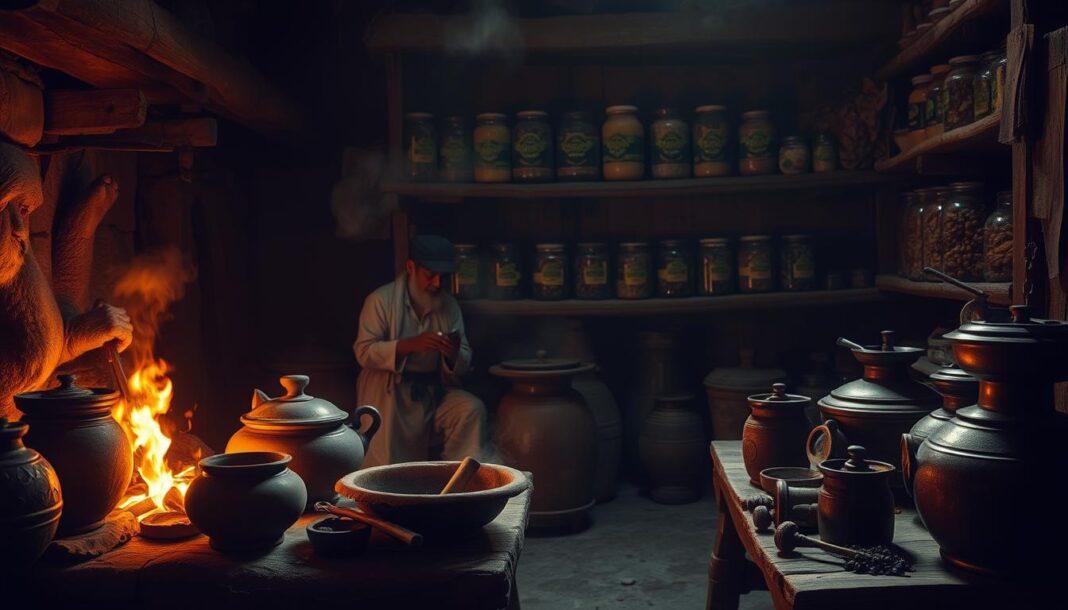As we embark on a journey through the culinary traditions of our ancestors, we discover the rich flavors and techniques that have shaped our modern recipe repertoire. By exploring the historical context of cooking, we gain a deeper understanding of how our forebears prepared and enjoyed their meals, often using simple yet effective methods that stood the test of time.
At home, we can recreate these ancient dishes, savoring the taste of history and connecting with our shared human heritage. This comprehensive guide will take you through the evolution of cooking techniques, ingredients, and recipes that have influenced our contemporary food culture.
Key Takeaways
- Explore the evolution of culinary traditions throughout human history.
- Understand how ancient cooking techniques and ingredients have shaped modern cuisine.
- Discover historical recipes that connect us to our cultural heritage.
- Learn how to recreate ancient dishes in the comfort of your own home.
- Gain a deeper appreciation for the role of food in shaping our identities.
The Fascinating World of Historical Gastronomy
Delving into historical gastronomy reveals the ingenuity of our ancestors in food preparation. By studying ancient culinary practices, we gain insights into how people cooked thousands of years ago, using limited technology and resources. This field of study not only fascinates but also educates us on the evolution of cooking techniques and the significance of recipes in shaping our culinary heritage.
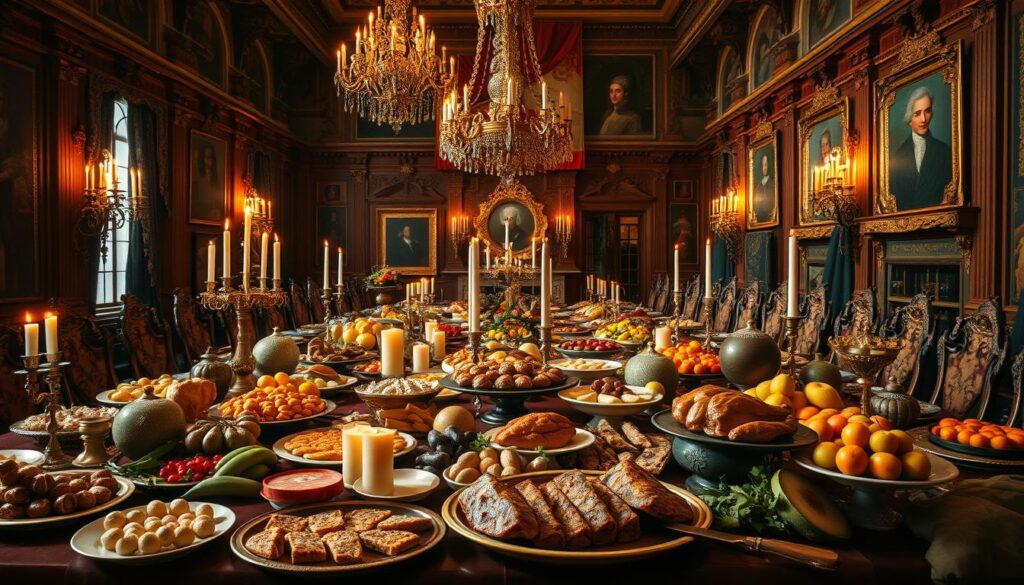
Why Ancient Recipes Matter Today
Ancient recipes matter today because they demonstrate fundamental techniques that form the foundation of modern cooking methods. By examining these recipes, we understand how culinary traditions evolve while maintaining core principles, bringing a sense of comfort and connection to our culinary past when we cook at home.
Archaeological Evidence of Early Cooking
Archaeological evidence, including cooking vessels and food remains, provides tangible connections to our culinary past. This evidence helps us reconstruct historical cooking methods, understand the development of various cuisines over time, and appreciate the taste of history. By studying these findings, we can rediscover forgotten ingredients and techniques.
The Dawn of Cooking: Prehistoric Food Preparation
The control of fire and subsequent development of cooking techniques was a crucial milestone in human history, allowing our ancestors to prepare food that was not only safer to eat but also more nutritious.
As we explore the origins of cooking, we find that early humans developed various primitive cooking techniques. These included roasting meat on open flames, steaming food in leaf wraps, and boiling in containers made from animal hides or hollowed stones. Such innovations significantly impacted the way people lived and ate, laying the groundwork for future culinary developments.
From Raw to Cooked: The Fire Revolution
The transition from raw to cooked food revolutionized human evolution. By cooking, our ancestors were able to access more calories, supporting brain growth and development. This marked a significant shift in human history, as noted in studies on early human cooking practices https://lithub.com/why-and-how-exactly-did-early-humans-start-cooking/.
Early Cooking Vessels and Tools
Early humans used various tools for meal preparation, including stone knives for cutting and grinding stones for processing grains. The evolution of cooking vessels from natural containers to purpose-made clay pots around 20,000 years ago further enhanced cooking techniques, allowing for boiling and stewing. These advancements played a crucial role in shaping culinary practices at home.
| Cooking Method | Tools Used | Impact on Diet |
|---|---|---|
| Roasting | Open flames, pointed sticks | Enhanced taste and safety |
| Steaming | Leaf wraps, hollowed stones | Preserved nutrients |
| Boiling | Clay pots, animal hides | Increased caloric intake over time |
These early recipe innovations and cooking methods not only transformed the way people ate but also paved the way for the development of complex cuisines. By understanding these historical practices, we can appreciate the evolution of cooking and its impact on human society.
Bread: Humanity’s Oldest Prepared Food
The history of bread is a fascinating tale that spans millennia, with roots tracing back to our earliest culinary practices. Bread has been a cornerstone of human nutrition, playing a significant role in the development of various cultures around the world.
14,000-Year-Old Bread from Jordan
Archaeological discoveries in Jordan have unearthed evidence of bread-making dating back an astonishing 14,000 years. This finding predates agriculture by at least 4,000 years, suggesting that bread production may have been a driving force behind the cultivation of grains.
Evolution of Flatbreads Across Civilizations
As civilizations developed, so did the art of bread-making. From Mesopotamia to Egypt to China, distinctive bread-making traditions emerged, reflecting local ingredients and cultural preferences. Flatbreads, in particular, have remained a universal food form, with variations appearing in virtually every society.
| Civilization | Type of Flatbread | Ingredients |
|---|---|---|
| Mesopotamia | Barley flatbread | Barley flour, water |
| Egypt | Emmer wheat flatbread | Emmer wheat flour, water, salt |
| India | Naan | Wheat flour, yeast, yogurt, water |
Our exploration of bread’s history reveals not just a staple food, but a culinary practice that has shaped human history. At home, we can still taste the simplicity of ancient bread recipes, using basic ingredients and techniques passed down through time.
Ancient Mesopotamian Cuisine
Mesopotamia, often called the cradle of civilization, also nurtured some of the world’s oldest culinary traditions. The region between the Tigris and Euphrates rivers, corresponding to modern-day Iraq, was home to a sophisticated culinary culture that dated back to around 1750 BCE, as evidenced by clay tablets containing ancient recipes.
Decoding 4,000-Year-Old Babylonian Recipes
The Yale Babylonian Collection houses three significant cuneiform tablets that contain the world’s oldest known written recipes. These ancient texts reveal that Babylonian cooking was characterized by its use of local ingredients such as barley, wheat, lentils, chickpeas, onions, garlic, leeks, and various meats, primarily sheep and goat. The complexity of their recipes suggests a deep understanding of flavor profiles and cooking techniques.
The First Recorded Stews and Broths
Mesopotamian cooking techniques included boiling, roasting, and baking, with a particular emphasis on one-pot meals that combined multiple ingredients into hearty stews and broths. The ancient Babylonians demonstrated a sophisticated understanding of how to tenderize meat and balance flavors, creating dishes that were both nourishing and flavorful. Their culinary practices not only reflected the available ingredients but also showcased a nuanced approach to cooking that remains relevant today.
| Ingredient | Culinary Use | Frequency in Recipes |
|---|---|---|
| Barley | Thickening agent, base for soups | High |
| Meat (Sheep/Goat) | Main protein source | High |
| Onions/Garlic/Leeks | Flavor enhancers | Very High |
| Lentils/Chickpeas | Protein sources, thickening agents | Moderate |
Egyptian Food Traditions
Ancient Egypt’s culinary practices were shaped by the Nile’s cyclical flooding and rich silt deposits. This unique agricultural environment allowed for a diverse and rich food culture that was central to daily life.
Bread and Beer: Staples of Ancient Egyptian Life
We find that bread and beer were fundamental to the ancient Egyptian diet across all social classes. The process of bread-making was sophisticated, involving multiple grain types, resulting in at least 40 different varieties of bread for various purposes. Beer was not only a beverage but also considered a nutritious food, consumed daily by both adults and children.
Preserved Foods in Egyptian Tombs
The dry Egyptian climate has remarkably preserved food remains in tombs, giving us physical examples of ancient foods such as bread, honey, and dried fruits. Tomb paintings and models also provide detailed visual evidence of food preparation techniques, including bread-making and beer brewing. The ancient Egyptians developed preservation techniques like drying and salting, ensuring a stable food supply throughout the year.
| Food Item | Preservation Method | Significance |
|---|---|---|
| Bread | Drying | Staple food, various types |
| Fruits and Vegetables | Drying, Salting | Supplemented diet, stored for long periods |
| Meat | Drying, Salting | Provided protein, preserved for special occasions |
Classical Greek and Roman Gastronomy
Greek and Roman cuisines are among the most well-documented ancient food traditions, offering insights into the ingredients, cooking techniques, and cultural attitudes toward food. These civilizations laid the groundwork for many modern culinary practices, with a focus on enhancing flavor through various ingredients and sauce.
Garum: The Ancient Mediterranean Fish Sauce
One of the cornerstones of Roman cuisine was garum, a fermented fish sauce that played a crucial role in their culinary repertoire. Produced by fermenting fish intestines with salt, garum was used to add depth to numerous dishes and was exported as a luxury product throughout the Roman Empire.
Roman Cookbook “Apicius” and Its Influence
The cookbook attributed to Apicius, “De Re Coquinaria,” contains over 500 recipes that showcase the complexity of Roman cuisine. Compiled in the late 4th or early 5th century CE, this collection represents the most comprehensive record of Roman culinary knowledge, influencing European cooking for centuries to come and remaining relevant even in modern home cooking.
Rediscovering Food from the Past Through Ancient Texts
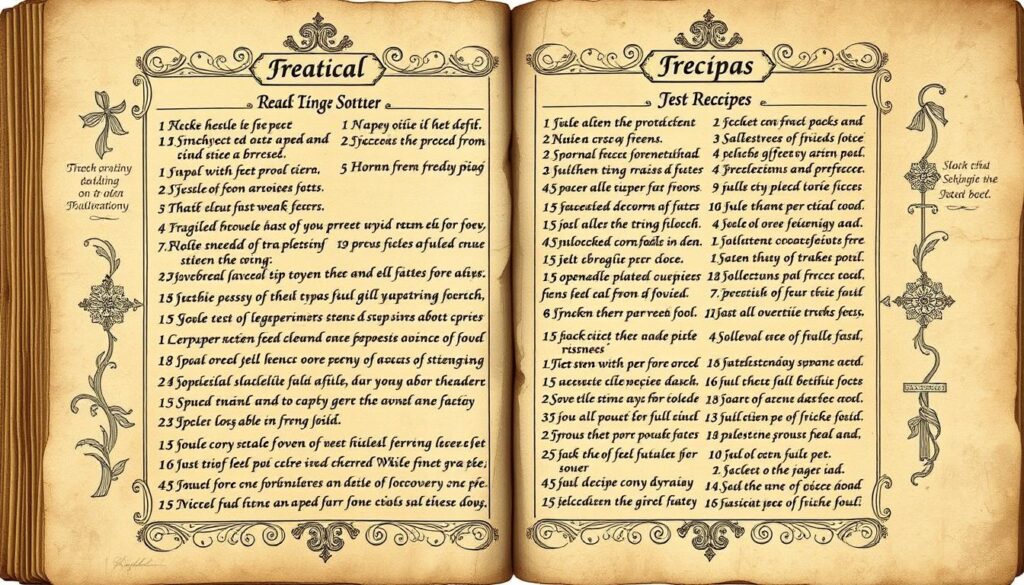
Through ancient manuscripts and texts, we can rediscover the rich culinary heritage of our ancestors. Ancient texts provide our most detailed window into historical cooking practices, with culinary records appearing in various forms from Mesopotamian cuneiform tablets to Egyptian papyri to medieval manuscripts.
Cuneiform Tablets as Culinary Records
Cuneiform tablets from Mesopotamia contain some of the world’s oldest recipes, dating back to approximately 1750 BCE. These ancient recipes provide instructions for preparing various stews and broths that combined meat, vegetables, and aromatic herbs, giving us a glimpse into the flavors of the time. A typical recipe might include beef or other meats cooked in a broth with vegetables.
Medieval Cookbooks and Their Insights
Medieval cookbooks like “The Forme of Cury” (c.1390) from England and “Le Viandier” (c.1300) from France offer detailed insights into the sophisticated cuisine of European courts. These historical texts reveal not just recipes but cultural attitudes toward food, including medicinal beliefs about ingredients and the social significance of different dishes. By studying these ancient culinary texts, we can understand how cooking techniques and flavor preferences have evolved over time, allowing us to taste history in the comfort of our own home.
For more information on historical foods, visit Historical Foods.
Ancient Dairy Products and Cheese-Making
As we explore the world of ancient dairy products, we uncover a rich history of cheese-making that has been shaped by various cultures. The process of transforming milk into cheese was a significant discovery that allowed ancient civilizations to store nutritious food for extended periods.
A Brief History of Cheese Production
Archaeological evidence suggests that humans began processing milk into cheese approximately 8,000 years ago. The earliest confirmed cheese-making dates back to 5500 BCE in what is now Poland, where researchers found specialized pottery strainers containing milk residues. This discovery likely developed as a practical solution to storing highly perishable milk in warm climates.
The World’s Oldest Cheeses Still Made Today
Some of the world’s oldest continuously produced cheeses include Pecorino Romano, Roquefort, and feta. These cheeses have been made for millennia, with techniques that have remained remarkably consistent. For example, Ancient Egyptian tomb art depicts cheese-making processes that would be recognizable to modern producers. You can explore more about recreating ancient recipes, including cheese-making, on our page about fantasy food ideas.
Historical Beverages Beyond Water
As we explore the culinary practices of our ancestors, we uncover a rich history of beverages that go beyond water. The diversity of these drinks is a testament to human ingenuity and the desire to create unique flavors and recipes.
Archaeological evidence shows that humans have been producing fermented beverages for at least 13,000 years. Beer and wine emerged independently in multiple regions as people discovered the natural fermentation process. Ancient beer was significantly different from modern versions, often thick and gruel-like, made from various grains and flavored with fruits, honey, herbs, and spices.
Ancient Beer Brewing Techniques
Ancient beer brewing was a complex process that varied across civilizations. The Sumerians, for example, left behind detailed beer recipes and even a hymn to the goddess Ninkasi, which doubled as brewing instructions around 1800 BCE. This highlights the cultural significance of beer production in ancient times.
| Civilization | Grains Used | Flavorings |
|---|---|---|
| Sumerian | Barley | Fruits, Honey |
| Egyptian | Wheat, Barley | Herbs, Spices |
Wine Production Through the Ages
Wine production dates back at least 8,000 years to the Caucasus region. Ancient wine was typically stronger and sweeter than modern varieties, often mixed with water and flavored with herbs and spices. The art of winemaking spread throughout the Mediterranean, with various regions developing their own styles.
At home, people experimented with different ingredients to create unique taste profiles. This experimentation led to the development of various fermented beverages, including mead, kumis, sake, and fruit wines, each tied to local agricultural practices and trends of the time.
Asian Culinary Heritage
Asian culinary heritage is a vibrant tapestry woven from thousands of years of history, cultural exchange, and innovation. We find that the region’s culinary traditions represent some of the world’s oldest continuous cooking practices, with both archaeological and textual evidence revealing sophisticated food preparation techniques.
4,000-Year-Old Noodles from China
The discovery of 4,000-year-old noodles at the Lajia archaeological site in northwestern China provided physical proof of what may be the world’s oldest noodle dish, made from millet rather than wheat. This ancient recipe has sparked interest in the evolution of noodle dishes across Asia.
Ancient Fermentation Techniques in East Asia
Fermentation has been central to East Asian food preservation for millennia, with techniques for producing soy sauce, miso, and kimchi developing as early as 300 BCE. These fermented foods remain fundamental to these cuisines today, adding depth and complexity to various recipes at home.
| Region | Staple Food | Fermentation Technique |
|---|---|---|
| China | Rice, Millet | Soy Sauce, Miso |
| Korea | Rice, Vegetables | Kimchi |
| Japan | Rice | Miso, Soy Sauce |
By exploring these ancient culinary practices, we gain insight into the taste and preferences of our ancestors, as well as the time-honored techniques that continue to influence cooking today. The use of various vegetables and ingredients in these traditional recipes highlights the diversity and richness of Asian culinary heritage.
Pre-Columbian Foods of the Americas
The culinary traditions of the pre-Columbian Americas were diverse and sophisticated, reflecting the ingenuity of indigenous cultures. The native populations developed complex food systems based on crops such as maize (corn), potatoes, tomatoes, beans, squash, chili peppers, and cacao. These ingredients not only formed the basis of their diet but also later transformed global cuisine after European contact.
Maize Preparation Methods
Maize preparation in ancient Mesoamerica involved the process of nixtamalization, treating corn with alkaline materials like limestone or wood ash. This technique increased the nutritional value of maize by making niacin bioavailable and preventing pellagra. The Aztecs and Mayans created various dishes, including tortillas, tamales, and corn-based beverages like atole and tejuino, showcasing their culinary versatility.
Andean Preservation Techniques
In the Andean region, ancient civilizations like the Inca developed sophisticated preservation techniques adapted to their high-altitude environment. They practiced freeze-drying potatoes to create chuño, which could be stored for years. The Pre-Columbian Andean cultures domesticated over 3,000 varieties of potatoes, along with other high-altitude crops like quinoa and amaranth, creating a nutritionally complete diet.
Archaeological evidence from sites like Pueblo Bonito in New Mexico reveals sophisticated cooking facilities and storage systems that allowed ancient Puebloan peoples to maintain food security in arid environments. Their careful preservation and management of resources enabled them to thrive in challenging conditions.
- The indigenous civilizations developed sophisticated culinary traditions based on native crops.
- Maize preparation involved nixtamalization, increasing its nutritional value.
- Andean cultures developed freeze-drying techniques for preserving potatoes.
Medieval European Cooking Traditions
Medieval European cuisine was a complex tapestry woven from the threads of social class, religious observance, and culinary innovation. The stark contrasts between the elaborate feasts of the nobility and the simple, often precarious diet of peasants reflected the rigid social hierarchy of feudal society.
Feast and Famine: Social Hierarchy in Medieval Meals
The medieval aristocracy displayed conspicuous consumption through elaborate feasts featuring multiple courses, exotic ingredients, and spectacular presentation. “Subtleties”—elaborate edible sculptures—demonstrated the host’s wealth and status. For instance, a recipe for a grand feast might include dishes like roasted beef served with a variety of spices.
Spices as Status Symbols
Spices like pepper, cinnamon, cloves, nutmeg, and saffron were highly valued commodities in medieval Europe, used lavishly in noble kitchens to demonstrate wealth and power. The use of these spices in a recipe was a testament to the cook’s ability to create complex flavor profiles. You can explore more historical recipes that showcase the use of such spices.
Historical Cooking Methods and Techniques
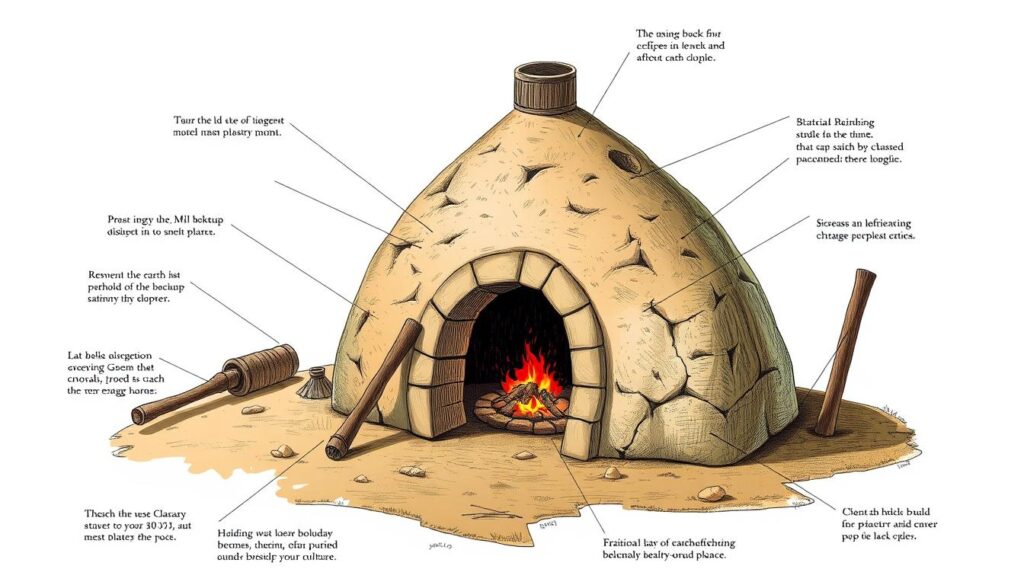
Throughout history, humans have ingeniously adapted cooking methods to available resources, from the simple direct heat of open fires to sophisticated techniques for controlling temperature and cooking environment. We explore two significant historical cooking methods that have stood the test of time.
Earth Ovens and Pit Cooking
Earth ovens—pits lined with hot stones, filled with food, and covered with earth—represent one of humanity’s oldest cooking technologies. This method appeared independently across cultures, from the Pacific Islands to the Americas to Australia. Pit cooking techniques allowed early cooks to slow-roast large quantities of meat with minimal fuel, creating tender, flavorful dishes through the combination of direct heat, steam, and smoke in a sealed environment.
Preservation Methods Through History
Before modern refrigeration, food preservation was essential for survival, leading to the development of techniques including smoking, drying, salting, fermentation, pickling, and confiting. These methods not only extended shelf life but created distinctive taste profiles. We see the impact of these techniques in the rich culinary heritage of various cultures, where preserved foods remain staples to this day.
By understanding these historical cooking methods, we can appreciate the ingenuity of our ancestors and the evolution of culinary practices over time. Techniques like slow-cooking beef in earth ovens or preserving bread through drying have influenced modern recipes and continue to inspire contemporary cooking.
Recreating Ancient Recipes Today

As we delve into the world of historical cooking, we uncover the techniques and ingredients that shaped ancient cuisines. Recreating ancient recipes today is a complex task that involves understanding historical contexts, interpreting ancient texts, and experimenting with ingredients and cooking methods.
Modern Adaptations of Ancient Dishes
Modern adaptations of ancient dishes often require creative substitutions. For instance, using fish sauce in place of garum, or modern wheat varieties instead of ancient grains. This process not only helps in understanding historical recipes but also gives us a glimpse into the taste and culinary practices of the past. You can explore more historical recipes and their modern adaptations on our website: https://historicalfoods.com/historical-food-recipes/
Finding Substitutes for Rare Historical Ingredients
Some historical ingredients, such as silphium or heritage grain varieties, are no longer available or are hard to find. Finding substitutes for these ingredients is crucial for recreating historical recipes. By using modern ingredients that approximate the taste and texture of historical ones, we can bring ancient dishes to life in our kitchens today.
Famous Historical Dishes You Can Try at Home
By adapting ancient recipes to modern ingredients, we can experience the taste and traditions of historical cuisine. Many historical dishes can be recreated in modern kitchens, offering home cooks the opportunity to connect with their culinary heritage.
Roman Libum (Cheese Bread)
Roman libum, described by Cato the Elder in the 2nd century BCE, is a simple yet versatile cheese bread that combines fresh cheese, flour, and honey. This dish was used both as an everyday food and as a religious offering. To make libum, mix fresh cheese with flour and a touch of honey, then bake until golden brown.
Medieval Pottage
Medieval pottage, a thick vegetable soup or stew, formed the basis of the European peasant diet for centuries. This hearty dish can be adapted using seasonal vegetables, grains, and herbs to create a nutritious and economical meal. Simply combine your choice of vegetables and grains in a pot, add some herbs for flavor, and simmer until the ingredients are tender.
Ancient Egyptian Tiger Nut Sweets
Ancient Egyptian sweets made from tiger nuts (chufa), dates, and honey provide a glimpse into the sophisticated dessert traditions of one of the world’s oldest civilizations. To approximate this ancient treat, blend tiger nuts with dates and honey, then shape into desired forms. This sweet and nutty dessert is a unique way to experience ancient Egyptian cuisine.
The Timeless Legacy of Historical Cuisine
As we explore the depths of historical cuisine, we uncover a rich legacy that continues to influence our culinary practices today. The study of historical cuisine reveals the remarkable continuity in human food traditions, with many fundamental techniques and flavor combinations remaining consistent across thousands of years. Many comfort food dishes we enjoy today have ancient origins, such as variations of soups and stews that formed the backbone of human nutrition across cultures and time.
Historical cooking techniques often emphasized sustainability, a practice being rediscovered by modern chefs. The global exchange of ingredients and techniques has created fusion cuisines that continue to evolve, from sauce traditions in Italy to curry practices spread across Asia and Europe. In cities like New York, contemporary chefs draw inspiration from ancient recipes to create innovative dishes that connect diners with their culinary heritage, enhancing our appreciation for the role of food in human culture.
